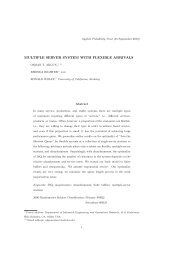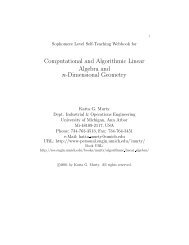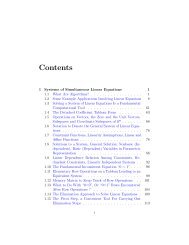Chapter 1 LINEAR COMPLEMENTARITY PROBLEM, ITS ...
Chapter 1 LINEAR COMPLEMENTARITY PROBLEM, ITS ...
Chapter 1 LINEAR COMPLEMENTARITY PROBLEM, ITS ...
Create successful ePaper yourself
Turn your PDF publications into a flip-book with our unique Google optimized e-Paper software.
26 <strong>Chapter</strong> 1. Linear Complementarity Problem, Its Geometry, and Applications<br />
for (1.11), is said to be a Karush-Kuhn-Tucker point (or abbreviated as a KKT<br />
point) if there exist Lagrange multiplier vectors y, u, such that x, y, u together satisfy<br />
(1.20) or the equivalent (1.19). So the LCP (1.19) is the problem of nding a KKT<br />
point for (1.11). We now have the following results.<br />
Theorem 1.13 If x is an optimum solution for (1.11), x mustbeaKKT point for<br />
it, whether Q(x) is convex or not.<br />
Proof. Follows from Theorem 1.12 and Corollary 1.1.<br />
Thus (1.20) or equivalently (1.19) provide the necessary optimality conditions for a<br />
feasible solution x of (1.11) to be optimal. Or, in other words, every optimum solution<br />
for (1.11) must be a KKT point for it. However, given a KKT point for (1.11) we<br />
cannot guarantee that it is optimal to (1.11) in general. In the special case when D<br />
is PSD, every KKT point for (1.11) is optimal to (1.11), this is proved in Theorem<br />
1.14 below. Thus for convex quadratic programs, (1.20) or equivalently (1.19) provide<br />
necessary and su cient optimality conditions.<br />
Theorem 1.14 If D is PSD and x is a KKT point of (1.11), x is an optimum<br />
feasible solution of (1.11).<br />
Proof. >From the de nition of a KKT point and the results in Section 1.2, if x is a<br />
KKT point for (1.11), it must be an optimum feasible solution of the LP (1.18). Let x<br />
be any feasible solution of (1.11).<br />
Q(x) ; Q(x) =(c + x T D)(x ; x)+ 1<br />
2 (x ; x)T D(x ; x) :<br />
The rst term on the right-hand side expression is nonnegative since x is an optimal<br />
feasible solution of (1.18). The second term in that expression is also nonnegative since<br />
D is PSD. Hence, Q(x) ; Q(x) > = 0forall feasible solutions, x, of (1.11). This implies<br />
that x is an optimum feasible solution of (1.11).<br />
Clearly (1.19) is an LCP. An optimum solution of (1.11) must be a KKT point for<br />
it. Solving (1.19) provides a KKT point for (1.11) and if D is PSD, this KKT point is<br />
an optimum solution of (1.11). [If D is not PSD and if a KKT point is obtained when<br />
(1.19) is solved, it may not be an optimum solution of (1.11).]<br />
Example 1.7 Minimum Distance Problem.<br />
Let K denote the shaded convex polyhedral region in Figure 1.7. Let P0 be the point<br />
(;2 ;1). Find the point in K that is closest to P0 (in terms of the usual Euclidean<br />
distance). Such problems appear very often in operations research applications.










